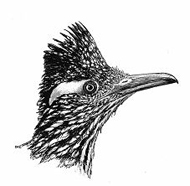The New Mexico Ornithological Society (NMOS) is pleased to announce the recipients of the 2011 NMOS and Ryan Beaulieu Research Grants. Each received $1000 to support their research on New Mexico birds.
NMOS Research Grant
Ronald Treminio, New Mexico State University – The use of stable hydrogen isotopes to elucidate the molt pattern of Burrowing Owls breeding across the Great Plains
Molt patterns of the Burrowing Owl are not well understood. Some recent research results suggest that not all Burrowing Owls undergo a complete molt prior to migration. I will use stable hydrogen isotopes to elucidate the molt patterns of Burrowing Owls across the Great Plains and use this information to trace migratory pathways and possibly winter locations. I predict that owls may exhibit one or more of the following molt patterns: (1) a complete molt on the breeding grounds; (2) a molt migration where they molt en route to wintering grounds; and (3) molt suspension where they suspend molt until they reach their winter locations. I will determine which pattern(s) are exhibited by determining the isotopic signature from a series of feather samples from adults and juveniles. This study is being conducted on seven grassland sites across the Great Plains, but funds from this grant will be used for travel and data collection at the two grassland sites in New Mexico – Kiowa National Grasslands and Armendaris Ranch.
Ryan Beaulieu Research Grant
Bethany Abrahamson, University of New Mexico – Elevational distributions and inter-specific competition in New Mexico hummingbirds
The range of overlap between the Black-chinned Hummingbird of the New Mexico lowlands and the Broad-tailed Hummingbird of the mountains provides an ideal system for investigating the interplay of competitive dynamics and physiology. The direct interactions among elevation, competitive success, and distribution limits have not been fully studied in general, and competitive dynamics between these two species have not been studied. I will identify the zone of overlap for these two species and then quantify relative abundance and record competitive interactions. Precisely defining the upper and lower range limits for these two species and the factors that play a role in setting those limits will be critical to predicting their response climate change. This study will examine how competition, urban habitat components, temperature, and air density affect range limits and predicted responses to climate change. This study will be conducted in the Sandia Mountains along two elevational transects: San Antonito to the Sandia Crest, and Placitas to Sandia Crest. Funds from this grant will pay for travel associated with this project and hummingbird food and feeder equipment.
